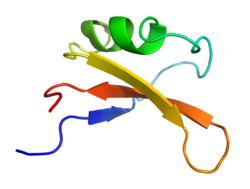Brazzein
| Brazzein ( Pentadiplandra brazzeana ) | ||
|---|---|---|

|
||
| Belt model according to PDB 2BRZ | ||
| Mass / length primary structure | 54 amino acids | |
| Identifier | ||
| External IDs | ||
| Inhibitor classification | ||
| MEROPS | I18 | |
Brazzein is a protein found in the fruits of the West African liana plant Pentadiplandra brazzeana . Compared to sugar, it has a sweetening power of 500 to 2,000 times with a low calorie content and temperature resistance. This makes it attractive as a sugar substitute in industrial food production.
discovery
During behavioral studies on monkeys in Gabon, Central Africa in 1984, the French anthropologists Marcel and Anette Hladik found that the animals preferred to feed on the red fruits of the liana plant Pentadiplandra brazzeana . The cause of this behavior was the enormous sweetness of the fruit. Brazzein was first isolated in 1994 at the University of Wisconsin – Madison .
structure
Brazzein is a small monomeric protein , consisting of 54 amino acids , with a pyroglutamate at the N-terminus and four intramolecular disulfide bridges , with a molecular mass of 6,473 Da . Brazzein is so far the smallest and one of the sweetest of the protein-based sweeteners. The three-dimensional protein structure shows an α-helix and three anti-parallel β-sheets . The tertiary structure shows no resemblance to the known structures of monellin and thaumatin .
Brazzein from natural sources consists of a mixture of pGlu-Brazzein (80%) and des-pGlu-Brazzein (20%), the des-pGlu-Brazzein being twice as sweet as the pGlu-Brazzein.
Use as an industrial sweetener
Brazzein is suitable as a sugar substitute for the industrial mass production of food due to its long-lasting and strong sweetening power as well as the good tolerance for diabetics. At 50 mg / ml, it is readily soluble in water, and both over a wide pH value range and heat-resistant, which is important for industrial processing e.g. B. in baked goods. In addition, its taste is more similar to sugar than most other sweeteners. The US companies Nectar Worldwide and Prodigene are working to manufacture synthetic brazzein inexpensively in large quantities using genetically modified corn. Currently, around one to two kilograms of brazzein can be obtained per tonne of corn. It is expected that regulatory approval will take several years. If Brazzein is successfully brought to market, it is expected that the traditional sugar industry will be affected. With sugar and other sweeteners, around 70 billion euros in sales are made every year.
Patents
Although the fruits of the Pentadiplandra brazzeana have long been known in Central Africa, brazzein is claimed by the University of Wisconsin as their own invention; The university rejects any connection with the natural occurrences in Gabon. The university holds three patents on compounds isolated from Pentadiplandra brazzeana and on the industrial production of brazzein (US Pat. No. 5,326,580, US Pat. No. 5,346,998, US Pat. No. 5,527,555). The patenting of Brazzein is therefore classified as biopiracy by GRAIN and Greenpeace . The cited patents from the 1990s have already expired; Patents based on natural substances - without the use of genetically modified organisms - are therefore no longer possible.
Individual evidence
- ↑ a b H. Izawa, M. Ota, M. Kohmura, Y. Ariyoshi: Synthesis and characterization of the sweet protein brazzein. In: Biopolymers. Volume 39, Number 1, July 1996, pp. 95-101, ISSN 0006-3525 . doi : 10.1002 / (SICI) 1097-0282 (199607) 39: 1 <95 :: AID-BIP10> 3.0.CO; 2-B . PMID 8924630 .
- ↑ Ming, D. & Hellekant, G. (1994): Brazzein, a new high-potency thermostable sweet protein from Pentadiplandra brazzeana B. In: FEBS Lett . Vol. 355, pp. 106-108. PMID 7957951 doi: 10.1016 / 0014-5793 (94) 01184-2
- ↑ UniProt P56552
- ↑ Caldwell, JE et al. (1998): Solution structure of the thermostable sweet-tasting protein brazzein. In: Nat. Struct. Biol. Vol. 5, pp. 427-31. PMID 9628478
- ↑ PDB 2BRZ
- ^ Hellekant, G. & Danilova, V. (2005): Brazzein a small, sweet protein: discovery and physiological overview. In: Chem. Senses. Vol. 30, pp. 188-189. PMID 15738210 doi: 10.1093 / chemse / bjh127
- ^ F. Angus, J. Dalzell, G. Birch: Ingredients Hanbook - Sweeteners - 2nd edition Leatherhead Publishing ed. 2000
- ↑ D. Ming, G. Hellekant: Brazzein, a new high-potency thermostable sweet protein from Pentadiplandra brazzeana B. In: FEBS letters. Volume 355, Number 1, November 1994, pp. 106-108, ISSN 0014-5793 . PMID 7957951 .
- ↑ Alexandra Rigos: Hunter of the biological treasure. ( Memento of the original from March 5, 2017 in the Internet Archive ) Info: The archive link was inserted automatically and has not yet been checked. Please check the original and archive link according to the instructions and then remove this notice. In: Greenpeace magazine. No. 2, 2002.
- ↑ Christoph Corves: Sweet Hunger - The Secret Sugar War ( Memento from February 13, 2004 in the Internet Archive ) NDR, 2002, documentation, 44 min, broadcast on March 31, 2003.
- ^ Environmental Audit House of Commons - Second Report - APPENDIX 7 - Trade Related Intellectual Property Rights (TRIPs) and Farmers' Rights Session 1998-99. 23 November 1999.
- ^ The European Patent Directive: License to Plunder Briefing published by Genetic Resources Action International, GRAIN, Barcelona, May 1998.
literature
- Walters, DE & Hellekant, G. (2006): Interactions of the sweet protein brazzein with the sweet taste receptor. In: J. Agric. Food. Chem. Vol. 54, pp. 10129-10133. PMID 17177550
- Zhao, Q. et al. (2005): Probing the sweet determinants of brazzein: wild-type brazzein and a tasteless variant, brazzein-ins (R18a-I18b), exhibit different pH-dependent NMR chemical shifts. In: Biochem. Biophys. Res. Commun. Vol. 335, 256-263. PMID 16105551
- Assadi-Porter, FM et al. (2003): Correlation of the sweetness of variants of the protein brazzein with patterns of hydrogen bonds detected by NMR spectroscopy. In: J. Biol. Chem. Vol. 278, pp. 31331-31339. PMID 12732626